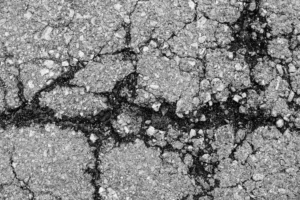Are you wondering how to keep your asphalt in top shape? Look no further! With a regular maintenance schedule, you can extend the life of your pavement and prevent costly repairs.
Did you know that by following a few simple steps, you can increase the lifespan of your asphalt by up to 50%? In this article, we’ll dive into the essential tasks you should include in your maintenance routine to ensure a smooth and durable surface for years to come.
Key Takeaways
- Seasonal cleaning and inspection should be performed in spring or fall to remove dirt, debris, and stains and carefully inspect for cracks, potholes, and signs of damage.
- Regular crack sealing and repairs are necessary to prevent water infiltration and further damage. This includes using a specialized sealant to fill cracks and promptly repairing potholes.
- Periodic sealcoating and resealing should be done to protect the asphalt surface from UV rays, water, oil, and other substances. This helps extend the lifespan, prevent cracks and potholes, and enhance appearance.
- Routine sweeping and debris removal are important to prevent debris accumulation, minimize damage to the asphalt, and improve aesthetics. Street sweeping and litter removal help prolong the lifespan and enhance the surface.
Seasonal Cleaning and Inspection
When should you perform seasonal cleaning and inspection on your asphalt?
The best time for this maintenance task is during the spring or fall, when the weather is mild and conducive to outdoor work.
Start by pressure washing the surface to remove any dirt, debris, or stains that may have accumulated. This will ensure a clean and smooth surface for inspection.
Once the surface is clean, carefully inspect it for any cracks, potholes, or signs of damage. Pay special attention to areas that may be prone to water pooling or excessive wear and tear.
Regular Crack Sealing and Repairs
To maintain your asphalt properly, regularly seal cracks and make necessary repairs. Crack filling and pothole repairs are essential tasks to ensure the longevity and durability of your asphalt surface. Here are three important points to consider:
- Crack filling: Cracks can develop in asphalt due to age, weather conditions, or heavy traffic. Regular crack filling prevents water infiltration, which can lead to further damage and deterioration. It involves filling the cracks with a specialized sealant to prevent moisture from seeping in and causing structural damage.
- Pothole repairs: Potholes aren’t only unsightly but also hazardous for vehicles and pedestrians. Promptly repairing potholes is crucial to maintain the safety and functionality of your asphalt surface. This process involves cutting out the damaged area, cleaning it thoroughly, and filling it with a durable patching material to restore the surface integrity.
Regularly addressing cracks and potholes through crack filling and pothole repairs will help extend the life of your asphalt, prevent more significant damage, and ensure a smooth and safe driving experience.
Periodic Sealcoating and Resealing
To maintain your asphalt properly, it’s important to periodically sealcoat and reseal the surface.
Sealcoating is the process of applying a protective layer to the asphalt surface, usually made of coal tar or asphalt emulsion. This layer acts as a barrier, protecting the asphalt from damage caused by UV rays, water, oil, and other harmful substances.
The benefits of sealcoating include extending the lifespan of the asphalt, preventing cracks and potholes, and enhancing the overall appearance of the pavement.
On the other hand, resealing involves applying a new layer of sealcoat over the existing one to ensure continuous protection. It’s important to reseal the surface every few years, depending on the condition of the pavement and the level of traffic it experiences.
Resealing helps maintain the integrity of the sealcoat and prolongs the life of the asphalt.
Routine Sweeping and Debris Removal
To effectively maintain your asphalt, you should regularly sweep and remove debris from the surface. Street sweeping and litter removal are crucial aspects of asphalt maintenance that help to prolong its lifespan and enhance its appearance.
Here are some key reasons why routine sweeping and debris removal are important:
- Prevents clogging: Regular sweeping prevents the accumulation of debris, such as leaves, dirt, and trash, which can clog the drainage system and cause standing water on the surface.
- Minimizes damage: Removing debris helps to prevent it from being pressed into the asphalt surface, which can lead to cracks and potholes over time.
- Improves aesthetics: Street sweeping and litter removal enhance the overall appearance of the asphalt, making it more visually appealing and inviting.
Scheduled Pavement Markings and Striping
Continue to maintain your asphalt by incorporating scheduled pavement markings and striping into your maintenance routine. Scheduled pavement markings and striping play a crucial role in enhancing safety, improving traffic flow, and ensuring compliance with regulations.
These markings are typically made using durable, high-quality paint or thermoplastic materials that can withstand heavy traffic and harsh weather conditions. By clearly delineating lanes, crosswalks, parking spaces, and other important areas, pavement markings help drivers navigate and pedestrians stay safe.
They also provide visual cues for parking lot organization and efficient traffic management. Regularly inspecting and refreshing these markings is essential to ensure visibility and effectiveness.
The table below provides a summary of recommended maintenance activities for scheduled pavement markings and striping.
| Maintenance Activity | Frequency |
|---|---|
| Inspection | Annually |
| Repainting | Every 2-3 years |
| Restriping | As needed, typically every 1-2 years |
Ongoing Drainage Maintenance and Repairs
Maintain the integrity of your asphalt by addressing ongoing drainage maintenance and repairs. Proper drainage is essential to prevent water from seeping into the asphalt, causing damage and deterioration over time. Here are some key points to consider when maintaining your drainage system:
- Regular cleaning: Clear debris, leaves, and other materials from drainage channels and grates to ensure effective water flow.
- Inspect for damage: Regularly inspect the drainage system for any signs of cracks, breakage, or blockages that could hinder water flow.
- Waterproofing techniques: Consider applying waterproofing techniques to protect the asphalt surface and extend its lifespan. This includes using sealants and coatings to prevent water penetration.
Conclusion
In conclusion, maintaining asphalt requires a well-structured maintenance schedule. By regularly cleaning, inspecting, sealing cracks, and repairing damages, you can prolong the lifespan of your asphalt pavement.
Additionally, periodic sealcoating, routine sweeping, and proper drainage maintenance are essential to ensure optimal performance.
Don’t overlook the importance of scheduled pavement markings and striping to enhance visibility and safety.
Remember, a well-maintained asphalt surface not only improves aesthetics but also adds longevity and durability to your pavement.



